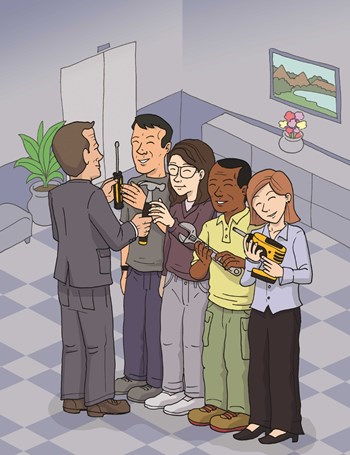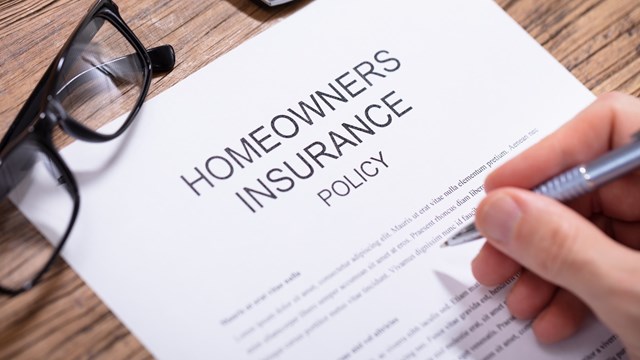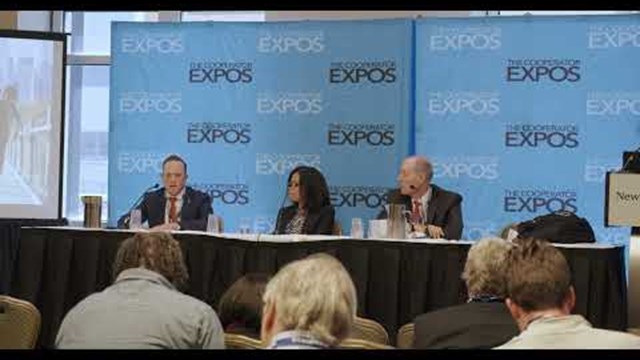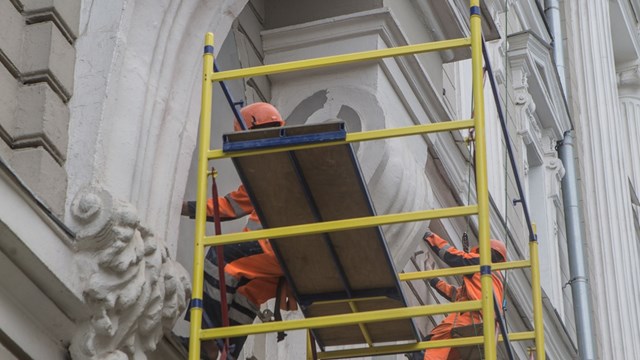
Say you’re in bed and you hear what sounds like the shower going, but it's late, and you're tired, so you pay it no mind. You wake up at 4 a.m. to get a glass of water, and find half the rooms in your apartment flooded— you forgot to turn the shower off! You throw blankets and towels on the floor to soak up the water, then you call your building’s maintenance staff.
With the aid of a dehumidifying machine, they’re able to get most of the moisture out of the flooded areas. But the wooden floor tiles themselves are heavily damaged—and a fair amount of water seeped into your downstairs neighbor's unit, damaging the ceilings, walls, and some artwork. Who’s responsible for restoring the flooring? And what about the water that poured into the apartment below?
The Basics
Finding out what systems and features in a shareholder’s co-op or condo unit are the owner’s responsibility and which are the building’s or association’s responsibility can be a very complicated subject. Many principles are universal but other details can vary from building to building, depending on the rules of that particular community.
According to the experts, within the individual unit, shareholders and unit owners are basically responsible for whatever’s within the four walls, and from floor to ceiling. Or, in another way of putting it, they're responsible for whatever they can see. Unfortunately, this would likely include those wooden floor tiles, unless your building administration decides to be generous.
One exception, however, is the electrical wiring inside the walls, says Carl Borenstein, president of Veritas Property Management in Manhattan, which manages about 80 buildings. “The building is only responsible for the electrical wiring up to the circuit breaker box,” he says. “Even though you don’t see the wiring after that point, it’s the responsibility of the shareholder” or the unit owner.
Then, what is the building or development responsible for? “While every building is different,” says attorney Leonard Ritz, of counsel, at the law offices of Adam Leitman Bailey, P.C. in Manhattan, “the general rule of thumb is that the building is responsible for everything in a common area of the property, and any building system—or portion of the system—that serves more than one apartment.”
This would include the hallways, lobby, elevators, basement, boilers or rooftop A/C, plus the electrical wiring from the point it enters the building from the street to the point it enters the circuit breaker or junction box.
Attorney Ronald A. Sher, founding partner of the law firm of Himmelfarb & Sher in White Plains, mentions a difference between condos and co-ops as far as responsibilities for repairs is concerned. In co-ops, he says, windows are the responsibility of the co-op; in condos, of the unit owner. HVAC units are the responsibility of the building in a co-op, but the responsibility of the unit owner in condos (the owners are responsible from the horizontal connections into the unit and the heating and cooling equipment).
Gray Areas
As in everything, there are some gray areas when it comes to who's obligated to fix what in a multifamily building. Places at the intersection of the wall and a piece of equipment are a frequent source of conflict, such as window replacement and repair, plumbing risers and valves (such as the valve under the sink that turns the water off), air conditioning equipment, and air conditioning sleeves within the walls.
Borenstein mentions the toilet as an example of how complex the situation is. “The tank, seat and flushometer belong to the owner, but the lead bend [the large, bending pipe under the toilet] belongs to the co-op. The toilet sits on a wax ring on the floor, which creates a seal. Sometimes the seal is compromised, the water begins to leak and causes damage.” This is another area of conflict, depending on where the damage occurs.
Attorney Jeffrey S. Reich, a partner with the law firm of Wolf Haldenstein Adler Freeman & Herz, LLP in Manhattan, says that radiators can be another of these gray areas. “The unit owner can cap it so it doesn’t work. Is it the shareholder’s responsibility? I think it is.” Even in these areas, however, it depends on the individual case, he says. “If you have a baseline problem because someone tossed a tennis ball down the toilet, that unit owner is responsible.”
Terraces and balconies can be another tricky area. Most people would agree that unit owners are responsible for any chairs, tables and so forth that they install on their terrace, but where the actual structure is concerned, it’s not always that simple—a leak from a terrace can damage the terrace below. That’s why some boards have upgraded the owner’s requirement regarding the terrace from merely keeping it free of leaves and debris to keeping it in good condition in general.
Alterations are yet another potentially sticky area—though perhaps a little less so than some of the others mentioned above, since most communities have rules and regulations regarding alterations spelled out explicitly in their governing documents. In general, if you do an alteration, you are responsible for it.
“If someone is doing an alteration,” says Seth Kobay, the president of Majestic Property Management Corp. in Great Neck, which manages about 15 buildings, “the responsibilities are spelled out in the alteration agreement.”
All this being said, readers will be happy to hear that, in Reich’s words, “I’ve represented 200 to 250 buildings, and I could count on one hand the number of times we’ve come across an issue that’s gray.”
It’s in the Docs
How can buildings avoid conflict where building systems’ maintenance and upkeep is concerned? First of all, residents should know the rules in their building; and for their part, building administrators should make sure the rules are clear, concise, and unambiguous.
For shareholders and owners, reading your governing documents is key when it comes to understanding responsibility for repairs. “Even though they are similar,” attorney Stephen Lasser, managing partner of Manhattan-based Lasser Law Group, PLLC, says, “governing documents for each building are unique, so it is important to check the governing documents rather than following general rules. In my experience, windows are the item that causes the most confusion, and where responsibility varies the most.”
On the building's side, “The more detail that can be put into the documents (proprietary lease for a co-op and the bylaws for a condo), the better,” says Ritz. “Unfortunately, a board cannot make these changes on its own—a super majority of owners is required for amending these documents. But the documents should strive to be as specific as possible, stating what individual owners are responsible for, as well as the limited extent of what the building is required to do.”
John Bonito, co-president, and Brian Scally, a managing agent with Scarsdale’s Garthchester Realty, add, “Most proprietary leases have two areas that indicate buildings’ responsibility and shareholder responsibility. These are usually paragraph 4 and paragraph 19. As an old saying that is quite appropriate goes, 'If it isn’t excluded, it’s included.’”
Once a building decides to amend its governing documents as far as repair and replacement responsibility is concerned, Lasser stresses that its attorney should carefully review these documents to make sure the conform with the building’s current or desired practices.
But let’s be realistic. Even if there are extremely clear clauses or clarifications in the lease documenting who’s responsible for what as far as repairs is concerned, many unit owners and shareholders who are immersed in their busy lives may not get around to reading them. Others, if they’re strongly opposed to these provisions, might even decide to deliberately ignore them.
What’s the best way to make sure shareholders and owners can better understand their maintenance obligations versus those of the building itself? Ritz believes that the best way is in a simple written document in a question-and-answer-format. One question, for example, might be, “Who is responsible if the shower body in my apartment leaks and causes damage to the apartment?”
The answer, Ritz says, should be detailed, explaining who is responsible for the plumbing repair, who is responsible for repairing the related damage in the apartment where the leak originated, and to what extent are different parties responsible for repairs in the lower apartments. As we’ve mentioned, the document should be prepared in consultation with the building’s attorneys to make sure it is consistent with the governing documents.
Bonito and Scally’s firm is one example of a management firm that has prepared a document about leak and damage responsibility. It goes into great detail, listing each item, such as “carpets,” “caulking” and “ceramic tile,” and details who is responsible for repairing it, the shareholder/unit owner or the co-op/condo. It also examines several hypothetical scenarios.
Documents like this are often given to owners before they move in. In addition, boards and management can reinforce this process by spelling out these rules at annual meetings, holding special informal meetings and sending out reminder bulletins. “None of these are sure things,” cautions Borenstein.
Documents aside, requiring homeowners’ insurance policies of all shareholders or unit owners is one way management can be sure that gaps can be closed and conflicts avoided. Such a policy can cover not only personal items such as computers and furniture, but also paint, wallpaper and flooring.
Warranty of Habitability
When you’re talking about responsibility for repairs, sooner or later, the subject of the Warranty of Habitability comes up. How does this differ between co-op, condo and rental buildings, and what exactly does it mean?
Under the warranty of habitability clause (technically known as NYS Real Property Law section 235(d)), says Sher, “A landlord is required to provide a tenant with a habitable, livable, safe, secure and sanitary apartment, inclusive of heat and hot water, free of insect infestation.”
A unit with a lock that doesn’t work, too many vibrations within the building, having to sleep over a boiler or second-hand smoke are all things that could violate the warranty of habitability, says Reich.
The warranty of habitability applies to rentals—and for this very reason, it applies to co-ops, too. Some people reading this article may be surprised to know that legally, in Ritz’s words, “cooperatives are rentals where the lessor happens to be a company in which the lessee also owns stock. For purposes of the warranty of habitability, the ownership of the stock is irrelevant.”
A condo unit, courts have ruled, is not subject to the warranty of habitability. One of the remedies available to co-op shareholders—to go to court and seek a reduction in maintenance charges if they believe the warranty of habitability has been breached—is therefore not available to condo unit owners, says Lasser.
Still, there’s one situation in which warranty of habitability could apply within a condo. This would be the case of a condo owner who rents out his apartment to a tenant. There, the unit owner is responsible under the warranty of habitability, even though that unit owner has no such warranty from the board.
In condo developments, the responsibility for repairs in both units and common areas is typically found within a section of the bylaws called “Repair and Maintenance.” More details spelling out respective rights and responsibilities can be found in the Condominium Act.
Oftentimes, it’s not easy to determine responsibility for repair elements. Most of the time, whether you’re talking about condos, co-ops or townhomes and when owners take good care of their units, problems won’t occur. For those times when they do, be sure to consult your attorney and building manager and look to your governing documents for answers.
Raanan Geberer is a freelance writer and a frequent contributor to The Cooperator.









4 Comments
Leave a Comment